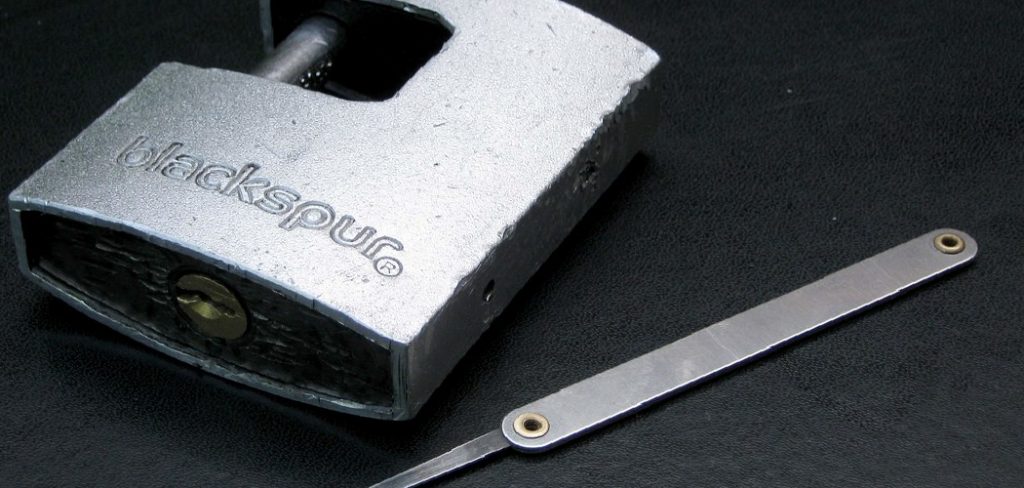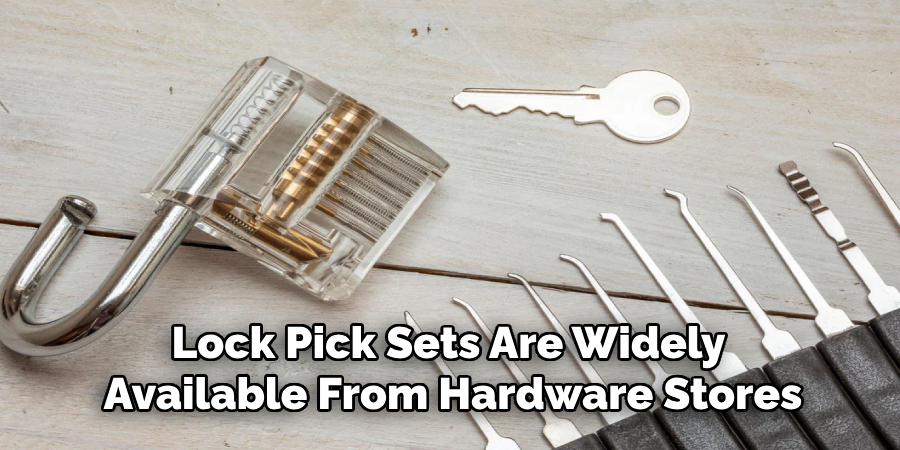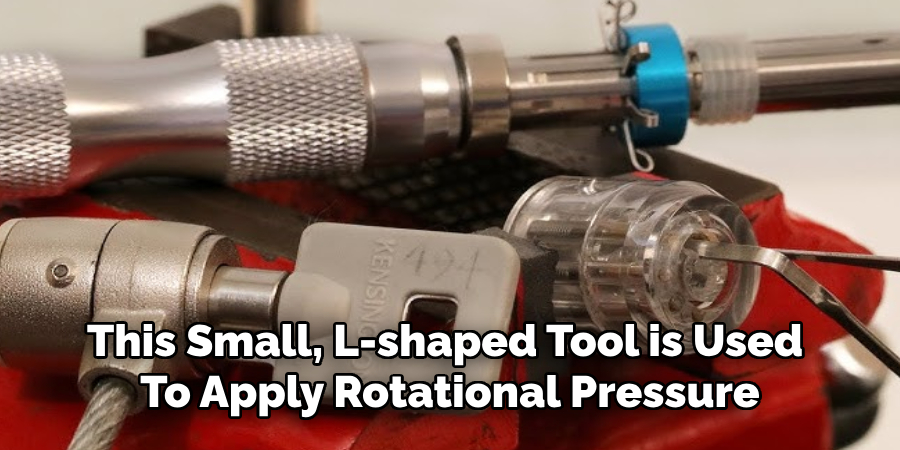There are various scenarios where you might need to pick a toolbox lock. Perhaps you’ve misplaced the key, or an emergency arises where immediate access to the tools inside becomes crucial. No matter the reason, knowing how to pick a tool box lock can be a valuable skill in such situations. However, it’s important to approach this topic with responsibility and integrity.

Lock picking should only be attempted on locks you own or have explicit permission to open. Unauthorized lock picking is unethical and a violation of the law in many regions. This article is designed to provide a clear, step-by-step guide for those looking to regain access to their locked toolbox efficiently and safely.
Always ensure you respect property rights and consider seeking professional assistance if needed. With the right knowledge and careful execution, you can handle toolbox lock challenges effectively.
Understanding Toolbox Locks
Toolbox locks are designed to secure your tools and prevent unauthorized access. Understanding the types of locks commonly used on toolboxes and how they function is essential for troubleshooting lock issues.
Common Types of Toolbox Locks
- Cam Locks – These are the most common locks found on toolboxes and involve a simple rotating cam mechanism that secures the lid or door. They are typically operated with a key and are known for their straightforward design.
Padlocks – Padlocks are often used as an additional layer of security. They can vary in complexity, from simple keyed designs to more advanced models with heavy-duty shackles and anti-picking features.
- 3. Combination Locks – These locks require a specific numeric code to unlock. Popular for their convenience, combination locks eliminate the need for carrying a key but require remembering the combination.
How Toolbox Locks Work
The basic mechanism of most locks involves a locking mechanism that engages with a shackle or metal bar to secure the toolbox. Keys or combinations align with internal components, such as pins or tumblers, allowing the lock to release. While simple in concept, some designs incorporate features to deter tampering or picking.
Why Some Locks Are Easier or Harder to Pick
The ease of picking a lock depends on its internal complexity. Basic cam locks or cheap padlocks with minimal pin designs can often be bypassed with limited effort. However, high-security locks may use anti-pick pins, hidden mechanisms, or tougher materials, making them significantly harder to compromise without the right expertise or tools.

Tools Needed for Picking a Toolbox Lock
Successfully picking a toolbox lock requires a combination of essential tools and, optionally, more advanced options depending on the lock’s complexity and your experience level.
Essential Tools
To start, you will need a tension wrench and a lock pick set. The tension wrench is used to apply slight rotational force to the lock, while the picks manipulate the pins inside. For beginners who don’t have professional tools, everyday items such as bobby pins or paperclips can serve as makeshift alternatives.
Straighten these items and bend one end into either a hook or an angled tip to replicate professional picks.
Optional Tools
If you’re dealing with more intricate locks or want to improve efficiency, specialized tools like rake picks and hook picks can be beneficial. Rake picks allow you to quickly move all pins simultaneously, while hook picks are ideal for addressing individual pins in a lock, offering precise control.
Where to Get Tools
Lock pick sets are widely available from hardware stores, locksmith suppliers, or online retailers. If dedicated tools aren’t an option, household items like hairpins, paperclips, or even safety pins can be adapted for the task. Remember that using these tools requires patience and an understanding of lock mechanisms to avoid damage or unintentional misuse.

Preparation Before Lock Picking
How to Assess the Lock Type and Security Level
Before attempting to pick a lock, you must identify the type of lock you’re dealing with and evaluate its security features. Common locks include pin tumbler, wafer, and disc detainer locks, each requiring different techniques and tools. Please pay attention to the lock’s construction and whether it has additional security features such as security pins or anti-pick mechanisms.
Understanding the type and complexity of the lock will help you determine the appropriate tools and strategy to use, increasing your chances of success.
Setting Up a Good Workspace with Proper Lighting
Having a comfortable and organized workspace is crucial for effective lock picking. Ensure that your work area is well-lit, as good lighting will help you see the lock’s intricate details more clearly.
A stable surface to work on will also allow you to focus solely on maneuvering your tools without distractions. Additionally, keep your tools neatly arranged for quick access, as efficiency and organization can save valuable time during the process.
Patience and Practice Mindset
Lock picking requires patience and practice. You’ll unlikely succeed on your first attempt, especially with more complex locks. Approach each attempt as an opportunity to hone your skills and deepen your understanding of lock mechanisms.
Stay calm and avoid frustration, as a clear and steady mind will lead to better results over time. Remember, persistence and consistent practice are key to mastering the art of lock picking.
How to Pick a Tool Box Lock: Basic Lock Picking Technique
Step-by-Step Guide
Mastering the basic lock-picking technique requires a clear understanding of the steps involved and a steady hand. Follow these steps for successful lock picking:
- Insert the Tension Wrench
Place the tension wrench into the lock’s keyhole. This small, L-shaped tool is used to apply rotational pressure to the lock cylinder. Gently turn it in the direction the lock would normally turn, applying consistent and slight pressure.

- Use the Pick Tool
Insert the pick tool into the lock, just above the tension wrench. The pick is used to manipulate the pins inside the lock to their correct positions.
- Feel and Lift the Pins
Inside the lock, you’ll find several pins. Gently use the pick tool to feel for these pins one at a time. Push each pin upward until you feel it set in place. A subtle click or a slight movement may indicate a pin has been successfully set.
- Adjust the Tension
Continuously adjust the pressure on the tension wrench as you pick each pin. Too much or too little tension can make it difficult to manipulate the pins correctly. The proper balance is key.
- Turn the Lock Open
Once all the pins are set, the lock cylinder should rotate. Turn the tension wrench to open the lock.
Common Mistakes to Avoid
- Excessive Tension
Applying too much tension with the wrench can seize the pins, making them harder to set.
- Rushing the Process
Lock picking requires patience. Avoid rushing, as it can lead to mistakes or damage to the lock.
- Forgetting to Adjust Tension
Keeping a consistent adjustment of tension during the process is crucial for setting the pins properly.
By following these steps and avoiding common errors, you can improve your skills and increase your chances of successfully picking a lock. Practice with different locks to refine your technique.
Using Alternative Methods to Open Toolbox Locks
Bumping Method
The bumping method involves using a specially crafted bump key to align the pins within a lock quickly. By applying slight tension and striking the bump key with a small, controlled force, the pins are momentarily set to the shear line, allowing the lock to open.
While this technique can be effective, it carries some significant risks. Excessive force can damage the lock, and improper use of bump keys may render the lock inoperable. Additionally, this method may not work on high-security locks that resist bumping.
Using Shim Tools for Padlocks
Shim tools can provide a non-destructive way to open certain padlocks. You can manually release the locking mechanism by inserting a thin, flexible metal shim into the gap between the lock’s body and its shackle.

This method requires precision and works best on older or low-quality padlocks. However, modern padlocks often feature anti-shim designs, reducing the effectiveness of this approach.
Using Bolt Cutters as a Last Resort
When all else fails, bolt cutters can be used to cut through a lock forcibly. While this method is practical in emergencies, it comes with significant downsides. The lock will be permanently damaged, and depending on the toolbox design, you may risk causing additional harm to the toolbox itself. Use this as a last resort, especially when other tools or methods are unavailable.
Legal and Safety Considerations
Reminder about Laws Regarding Lock Picking and Property Rights
It is critical to understand that lock picking, bypassing, or forcibly opening any lock without proper authorization can have serious legal consequences. Laws regarding lock picking and tampering with locks vary by jurisdiction, but unauthorized attempts are frequently considered criminal activities, such as theft, trespassing, or vandalism.
To avoid legal troubles, always ensure you have the right to access the property. Never attempt to pick or damage a lock that does not belong to you unless you have received express permission from the owner.
Importance of Only Picking Locks You Own or Have Explicit Permission to Open
Lock picking is a skill that must be used responsibly. It is both ethical and legal only to practice this craft on locks you personally own or on those you have clear, explicit consent to manipulate.
Practicing on your locks ensures you stay within your rights while honing your skills. Unauthorized lock picking, even if not intended for malicious purposes, could still lead to misunderstandings, legal issues, or harm to your reputation.
Safety Tips to Avoid Injury or Damage to Your Tools
When working with locks, prioritize safety to prevent injury. Use proper tools designed for lock picking, and avoid makeshift alternatives that could slip or break. Always wear protective gloves and ensure your workspace is well-lit to prevent accidents.
Press gently to avoid breaking lock picks or damaging the lock itself. Remember that forcing tools or using excessive strength could harm both the lock you’re working on and the tools you’re using, leading to costly repairs or replacements.
Tips for Preventing Future Lockouts
Preventing lockouts begins with proactive measures. Store spare keys in safe and easily accessible locations, such as a trusted neighbor’s house or a secure key lockbox. Avoid common hiding spots like under mats or rocks, as they are easily discovered. Label your keys clearly but discreetly, ensuring they can be identified without sharing sensitive information.
Alternatively, consider memorizing lock combinations or keeping a digital record of combination codes in a secure app. Investing in high-quality locks, including keyless or smart locks, can also minimize the risk of lock-related issues. These advanced solutions often offer remote access or backup options, adding convenience and security.

Taking the time to plan ahead and implement these strategies can save you from the frustration and inconvenience of being locked out in the future.
Conclusion
Understanding “how to pick a tool box lock” can be a useful skill in emergencies, but it is essential to exercise caution and adhere to legal and ethical guidelines. Lock picking requires patience and practice, and it should only be done on locks you own or have explicit permission to work on.
Always respect property rights and avoid any activity that could be considered unlawful. When faced with uncertainty or complex issues, seeking the help of a professional locksmith is often the safest and most reliable choice. Remember, preparedness and responsibility are the keys to successful outcomes.
About
Safety Fic is a distinguished figure in the world of Diy design, with a decade of expertise creating innovative and sustainable Diy solutions. His professional focus lies in merging traditional craftsmanship with modern manufacturing techniques, fostering designs that are both practical and environmentally conscious. As the author of diy, Safety Fic delves into the art and science of Safety Fic-making, inspiring artisans and industry professionals alike.
Education RMIT University
(Melbourne, Australia) Associate Degree in Design (Safety Fic) Focus on sustainable design, industry-driven projects, and practical craftsmanship. Gained hands-on experience with traditional and digital manufacturing tools, such as CAD and CNC software.
Nottingham Trent University
(United Kingdom) Bachelor’s in diyfastly.com and Product Design (Honors) Specialized in product design with a focus on blending creativity with production techniques. Participated in industry projects, working with companies like John Lewis and Vitsoe to gain real-world insights.
Publications and Impact
In diy, Safety Fic his insights on indoor design processes, materials, and strategies for efficient production. His writing bridges the gap between artisan knowledge and modern industry needs, making it a must-read for both budding designers and seasoned professionals.
